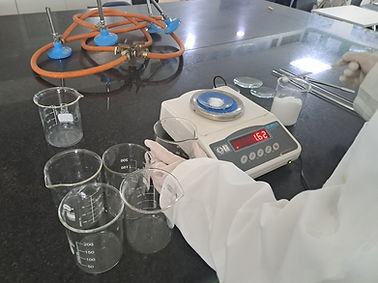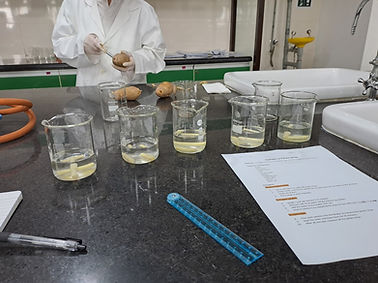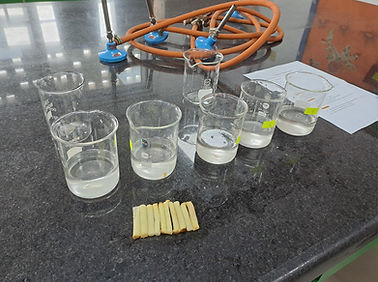
Osmosis in Potato Strips
Chemicals and apparatus:
potato, cork borer, knife, salt, distilled water, beakers, weighing scale, watch glass, spatula, glass rod
Experiment date: 3/10/25
Written by: Sophia Han

i)
Prepare potato strips
-
Use a cork borer to make 18 potato strips.
-
Using a knife, remove the potato skin on the strips and cut them so that all of the strips are at 6 cm.
-
Put 3 strips in each of the 5 beakers.
*Measuring the initial weight can also be considered! It would be a more direct method to see the change in the potato strips.
ii)
Prepare solution
-
Weigh 0 g / 2 g / 4 g / 6 g / 8 g of salt and put it in a beaker.
-
Measure 100 mL of water using a measuring cylinder.
-
Add the water to the beaker with salt.
-
Make 5 solutions in total by repeating the steps 4-6 but with the rest of the (amount of) salt.


iii)
Experiment
-
Pour each solution into the beaker to immerse the potato strips.
-
Start the timer and leave the potato strips inside the beaker for 20 minutes.
iv)
Measure & Compare
1. After 20 minutes, measure the length (and/or weight) of all potato strips.
2. Compare them with the initial measurements.

Discussion
Results:
The length and mass of the potato strips decreased slightly as salt concentration increased, showing an inverse relationship between them.
Explanation:
Osmosis is essentially the net movement of water molecules from a region of higher water potential (lower solute concentration) to a region of lower water potential (higher solute concentration) across a semi-permeable membrane.
The plasma membrane is semi-permeable, controlling what goes inside or outside of the cell. While polar molecules like glucose and RNA cannot pass the membrane on its own and requires transport proteins to do so, non-polar molecules like carbon dioxide and oxygen can easily diffuse across the cell membrane. Moreover, water, despite being a polar molecular, is able to pass through the membrane because of its small size.
There are three major types of solutions: hypertonic, isotonic, and hypotonic.
-
Hypertonic: lower water potential outside the cell than inside --> water moves out --> cell shrivels (plasmolyzed plant cell, crenated animal cell)
-
Isotonic: same water potential as the cell -->
-
Hypotonic: higher water potential outside the cell than inside --> water moves in --> cell swells (turgid plant cell, animal cell becomes lysed after swelling due to the lack of a cell wall)
In our experiment, as the salt concentration increased, more water inside of the potato had to travel out so that a state of equilibrium is reached (no net movement of water). Due to the release of water inside the potato strips, their mass decreased, hence leading to these results.

